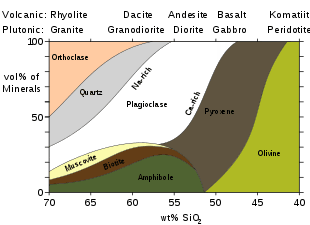Alkali feldspar granite
Alkali feldspar granite, some varieties of which are called 'red granite',[1] is a felsic igneous rock and a type of granite rich in the mineral potassium feldspar (K-spar). It is a dense rock with a phaneritic texture. The abundance of K-spar gives the rock a predominant pink to reddish hue; peppered with minor amounts of black minerals.[2][3]

| Igneous rock | |
Alkali feldspar granite. Holocrystalline texture, coarse-grained. Great amounts of potassium feldspar (orthoclase, pink-reddish in colour) | |
| Composition | |
|---|---|
| Primary | Potassium feldspar, quartz |
| Secondary | Plagioclase; dark minerals |
Chemical composition
As shown in the QAPF diagram, alkali feldspar granite contains between 20% - 60% quartz. Less quartz content would lead to "quartz alkali feldspar syenite". More than 90% of the total feldspar content is in the form of alkali feldspar. Less than that amount would designate the rock as a granite.[4]

Other incorporated silicate minerals may include, very minor amounts of plagioclase feldspar, mica in the form of muscovite and/or biotite, and amphibole (often hornblende). Oxide minerals such as magnetite, ilmenite, or ulvospinel. Some sulfides and phosphates (mainly apatite) may also be present.
Occurrence
Alkali feldspar granites generally occur with other alkali-rich granitoids, such as monzogranite and syenogranite, forming part of the A-type granites. They are found in a wide range of tectonic settings and their origins remain uncertain.[5]
Uses
Granitic rocks in general are of interest to geologists, geochemists, etc., because they provide 'crystallized' telltale clues of their environment of formation.[6]
Alkali feldspar granite is used as construction material in the form of dimension stones, and polished slabs or tiles for building facades, pavements, and kitchen countertops.[3]
References
- "The Chief Commercial Granites of MA, NH and RI (see, for example, pp. 179-180)" (PDF). US Geological Survey.
- "FAQ - What is Granite?". US Geological Survey.
- "Granite: Characteristics, Uses and Problems". US General Services Administration. Archived from the original on 2015-12-09. Retrieved 2015-12-11.
- "Field Classification and Description of Soils and Rock" (PDF). US Environmental Protection Agency.
- Bonin B. (2007). "A-type granites and related rocks: Evolution of a concept, problems and prospects" (PDF). Lithos. 97 (1–2): 1–29. doi:10.1016/j.lithos.2006.12.007. Archived from the original (PDF) on 2014-02-11.
- "Granite and Granodiorite". US National Park Service.